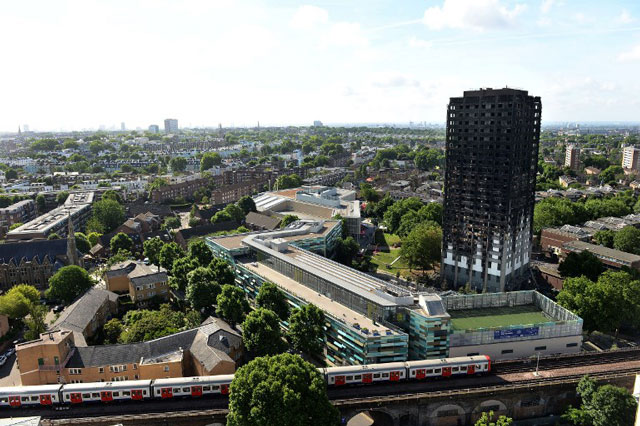
London, United Kingdom | AFP | One week on from the fatal London tower block inferno, the macabre smell of the burnt-out building clings to a traumatised neighbourhood, where every conversation is peppered with indignation.

London, United Kingdom | AFP | One week on from the fatal London tower block inferno, the macabre smell of the burnt-out building clings to a traumatised neighbourhood, where every conversation is peppered with indignation.
Some 79 people are presumed dead after last Wednesday’s blaze, which quickly engulfed the 24-storey social housing block.
As Prime Minister Theresa May apologised in parliament for the state’s failure to “help people when they needed it most” in the initial aftermath of the fire, locals in north Kensington were still struggling to come to terms with the disaster.
Margaret Thomson, 47, lives in one of the four-storey buildings which surround the charred tower.
She is therefore allowed to cross the police cordon surrounding the burnt-out shell of the Grenfell block, where the grisly search for identifiable human remains continues.
“One week and we still don’t know how many neighbours died! It’s a real shame,” she told AFP.
“Do you think it would be the same if it would have been a white, affluent building? Of course not!”
– ‘We need the truth’ –
Home-made posters with pictures of the missing are plastered around this working-class enclave in Kensington, the richest district in Britain.
“We see signs of missing people everywhere,” said Thomas, a Londoner in his 20s.
“They were all in that building, and they died in that building. We need the truth,” he told AFP.
“Let people know that they lost their loved ones, let them start getting on it, what they need to do: a funeral, a life after their loved ones. We cannot continue like this.”
No-one knows, and it may never be accurately known, how many people were in the concrete tower of 120 apartments when fire took hold in the lower floors in the early hours of June 14.
In a tower inhabited mostly by people of foreign origin — including many Moroccans and Somalis, some with the right paperwork, some without — the custom was to put up relatives, friends and acquaintances, especially during Ramadan, where families meet late at night for the iftar, the fast-breaking meal.
Police commander Stuart Cundy has called for anyone with information about themselves or others in the tower, who for any reason has not come forward, to do so.
“We will continue to do everything we can to find answers to those who are missing loved ones,” said Cundy, who is leading the investigation.
A week on, 10 people from the west London tower were still in hospital, six in a critical condition.
– Rumours in a vacuum –
The uncertainty about the number of victims has given rise to rumours on the street just as virulent as those on social networking websites.
They accuse the media of covering up the truth because the victims were mostly poor and of foreign origin, living in a 1970s social housing block in plush Kensington.
The sad truth is that the fire engulfed the tower with such intensity — for which many blame the newly-fitted exterior insulation cladding — that it consumed everything inside the apartments it ravaged.
London’s Metropolitan Police has published photos and videos from inside the tower.
They show apartments completely burnt-out — a rare sight in most cases of building fires — where furniture, fittings and, quite possibly, victims, have been reduced to mere ashes.
After having carefully advanced through the debris and consolidating areas that were hitherto deemed unsafe, the firefighters and experts have finally been able to reach all the apartments inside.
But the devastation is so great that it will take days, weeks, or even months to reach a definitive death toll.
Then comes the arduous process of identifying the victims, which only prolongs the agony for grief-stricken relatives.
Following the September 2001 attacks on the World Trade Center in New York, it took more than six months to reach a final death toll.
The estimate at the end of that month was more than 6,700 missing or dead — a figure which settled at 2,800 in January 2002.
– First funeral –
On the other side of London on Wednesday, the first funeral of one of the victims took place at the East London Mosque.
Mohammad Alhajali, one of the few formally identified so far, was a Syrian refugee who came to Britain with his brother in 2014.
While his brother escaped alive, the engineering student did not.
His parents were helped by the British authorities to make it from Syria in time for the funeral.
“May he rest in peace and may no other family have to experience the pain we have had to endure over such a short period,” they said in a statement read outside the mosque.
Tags Britain fire Grenfell Scene